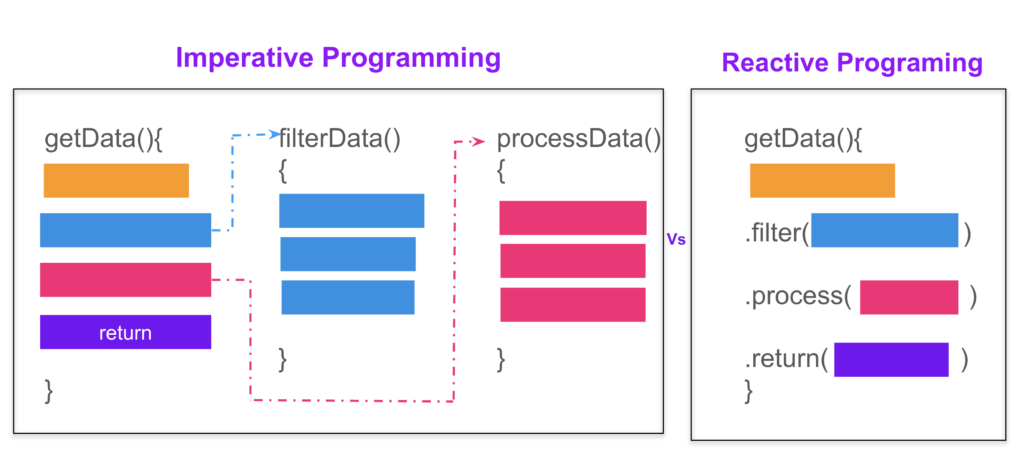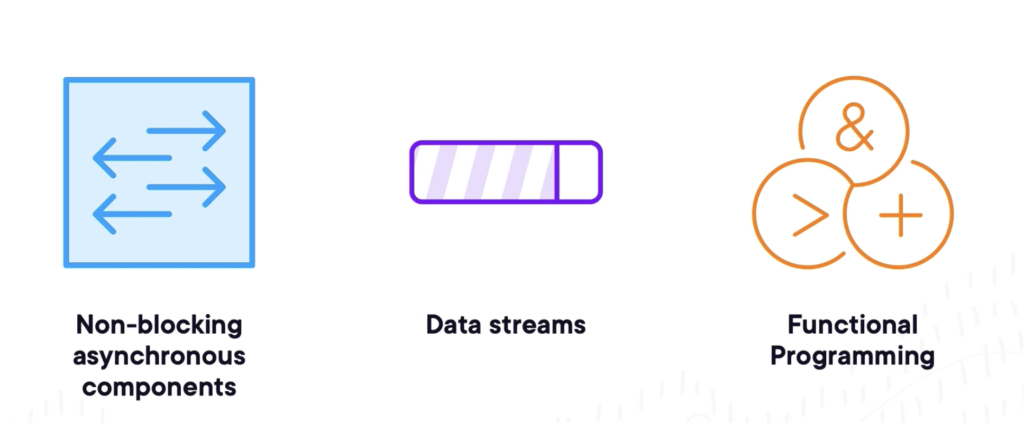Last Updated on September 22, 2024 by KnownSense
The advent of microservices architecture has revolutionized how we design, build, and test applications. This approach requires us to consider various aspects of distributed systems, including availability, resiliency, and performance. As we confront challenges related to processing large volumes of data, traditional methods may fall short. This shift necessitates a fresh perspective and new strategies for data handling.
Reactive Programming offer a solution by being responsive, adaptive, and flexible in the face of failures. This asynchronous and non-blocking paradigm supports the development of highly responsive applications capable of managing high-load traffic without sacrificing performance.
Comparison with Imperative Approaches

We all know what programming is about. We write code, we’re presenting classes and methods with the purpose of instructing computers on how to perform specific actions. But, what about reactive? What does it mean to be reactive? Well, the easiest way to explain reactive programming is to first look at imperative programming. Let’s say our user needs to access and process some data. To do this, we need to write a method that contains instructions for how to connect to and retrieve from a data source. Accessing and retrieving data is not done in an instance, especially if we are talking about a large amount of data. The moment we connect to a data source, code execution blocks until we get the entire data block we requested. After we receive the data, we may want to perform some other operations like filter part of the data and process it. These actions are usually done via separate methods. Finally, in the getData method, we can return the processed data. This process works pretty well, but by using reactive programming, we can actually tackle some of the issues we noticed earlier.
Reactive programming introduces three key elements that enhance efficiency:

- Non-Blocking Asynchronous Components: This allows for operations to proceed without waiting for each task to complete, improving overall responsiveness.
- Data Streams: These enable continuous and real-time handling of data, rather than waiting for complete data blocks.
- Functional Programming: This paradigm supports more declarative and concise code, making it easier to manage and reason about.
Combining these three aspects results in a more efficient way of writing and managing code execution. Let’s see exactly how. When we use reactive programming, we are not dealing with blocking code anymore. Code execution will continue even when we are dealing with blocking operation, such as calling external data sources. All the time spent while our thread is blocked, we can now use to perform other actions. Our data source no longer comes in bulk, but as a data stream. Instead of getting the entire data bulk back in one go, we can decompose it and receive it in pieces, one by one, until all data is transferred. Finally, we have functional programming. Asynchronous code can be implemented either with callbacks or futures. However, by using this, we can easily fall for bad practices, such as callback hell, or we can unintentionally block futures. There is actually a third way, and that is through functional programming. Basically, we change our imperative blocks of codes into functions and chain them so that we can obtain the desired result.
Key Use Cases
Reactive programming offers powerful benefits, but it isn’t always necessary or appropriate for every scenario. Here are some specific situations where reactive programming truly excels:
- I/O Intensive Applications: Reactive programming is particularly useful for applications that perform numerous I/O operations, such as accessing disk storage, querying databases, or making network requests. Its non-blocking nature helps efficiently manage these tasks.
- UI Controllers: Mobile applications, which frequently need to fetch data from multiple sources to update their interfaces, can benefit from reactive programming. This approach facilitates smooth and responsive user interactions by managing data streams effectively.
- Internet of Things (IoT): In the IoT realm, where data often comes from sensors, outputs, and triggers, reactive programming can adeptly model and handle event streams, providing a robust framework for managing real-time data flows.
Essential Topics
In the other articles, we will explore the realm of reactive programming and build a production-ready reactive application. Key topics will include:
- Understanding reactive streams
- Developing reactive applications with Spring WebFlux
- Utilizing router functions as an alternative to the annotated-based Spring MVC programming model
- Integrating with other services using Spring WebClient
- Preparing applications for production through unit and integration testing
By the end of this journey, you’ll have the skills to create, develop, and test reactive applications using Spring WebFlux 6. A basic understanding of Java and Spring Web is recommended before we start.